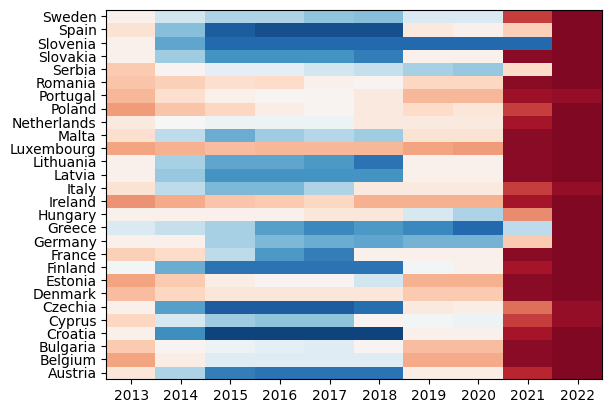The “Undeclared War on Women in Europe” is a cross-border investigation by the European Data Journalism Network (EDJNET) and coordinated by the Mediterranean Institute for Investigative Reporting. A team of 16 members from EDJNET contributed to the series of stories, which revealed the increasing cases of violence against women and femicides. The data analysis and visualization for the investigation were carried out by the iMEdD Lab.
Illustration: Louisa Karageorgiou
How we analyzed nine months of conversation about the Greek wiretapping scandal on Twitter

The working methodology as part of the research collaboration presented by iMEdD Lab and Datalab, on the analysis of the conversation about the wiretapping case on Twitter.
The story reports on the issue of femicides and violence against women in 28 European countries from 2010 to 2021, focusing on the two years of the Covid-19 pandemic in Europe (2020-2021) for which European institutions had no updated data
The data analysis is based on two primary sources: the European Institute for Gender Equality (EIGE) reports and EUROSTAT. At the same time, 19 independent newsrooms across Europe worked on complementing the dataset by making requests to relevant authorities (police, ministries of justice, and several national agencies) asking for more complete or updated data, with the goal of creating an updated map of violence against women in the European continent
The EIGE data
The EIGE report (EIGE Report 2021, EIGE’s indicators on intimate partner violence, rape, and femicide: EU state of play”) focuses on femicides, rapes, and four types of intimate partner violence; physical, sexual, economic, and psychological. The report provides data until 2018 that are not complete for all countries because of differences in national data collecting methods. The teams participating in the investigation sought and contributed as up-to-date data as possible, which was audited based on EIGE guidelines.
Definitions
According to EIGE, Intimate Partner Violence (IPV) occurs when a current or former spouse or partner is physically, sexually, psychologically, or financially abusive to their relationship, regardless of whether or not the abuser currently resides in the same household as the victim.
- Femicide
It’s important to note that EIGE uses the statistical definition of “Femicide” as “the killing of a woman by an intimate partner and the death of a woman as a result of a practice that is harmful to women.”
- Physical violence
Any conduct that causes physical harm to the current or former partner through the use of unlawful force. Physical violence can take the form of significant or minor assault, deprivation of liberty, manslaughter, or attempted homicide, among other things.
- Sexual violence
Any sexual act committed without the victim’s consent. Sexual assault and rape are manifestations of sexual violence.
- Economic violence
Any action or behavior that harms the current or previous spouse economically. Economic violence can take the form of, among other things, property destruction, limiting access to financial resources, education, or the labor market, or refusing to fulfill economic obligations such as alimony.
- Psychological violence
Any act or behavior that causes psychological injury to a current or past romantic relationship, such as coercion, defamation, verbal abuse, or harassment.
Glossary of statistical terms for beginners

A glossary of basic terms for the beginners in data analysis and for anyone who has queries about statistical concepts that are used in the public discourse.
The problem with the data
While reporting on femicides and violence against women, we were faced with a grim reality regarding the lack of data on the matter. Each member state in Europe measures instances of violence against women differently, applying different variables and classification systems. This practice makes it impossible to merge the data into a single database. Each institution (e.g., Eurostat, WHO, etc.) collects data from administrative data sources such as the police, courts, and hospitals. However, all these data sources not only use a different definition of femicide, but they measure different variables. For instance, some measure the number of victims, while others the number of perpetrators.
The act of the Istanbul Convention and EIGE recommendations for the European Union (EU) and its member states to improve data collection on intimate partner violence by the police, justice sector, and civil society have prompted a new political perception and more productive debate, resulting in legislative changes.
Six member states — Belgium, Spain, France, Lithuania, Portugal, and Slovenia — have introduced hatred, contempt, or hostility towards a person on the grounds of sex, gender-based violence connotation, or sexism as aggravating circumstances.
In six member states – Bulgaria, Greece, Spain, France, Italy, and Luxembourg – the homicide of a cohabiting or non-cohabiting intimate partner is considered aggravated. Three member states do so for sexual violence: Germany, Italy, and Poland.
One-third of member states distinguish between intentional and unintentional or involuntary manslaughter. This data is important for finding other unintended homicides that pertain to the notion of gender-based homicides.

Missing data per country and year. The darker red, the more data missing
Adding data in the EIGE Indicators
During our cross-border investigation, we worked with 18 independent newsrooms to supplement the EIGE dataset, which only included records up to 2018. As there were variations in the way each country measured violence against women, our team of journalists made official requests to their national institutions responsible for collecting such data. We only included data in our analysis that we were confident was consistent with EIGE standards.
Our process of validating the data involved reviewing the documentation of data collection from each national authority and comparing it to the EIGE report to ensure consistency. In cases where we received data that extended before 2019, we checked if it matched the EIGE report’s data. For example, if country X had 100 recorded incidents of psychological violence against women in 2018 in the EIGE report, we checked if the data from the reporters also had 100 incidents in 2018. If the numbers matched, we assumed that the data for subsequent years was also accurate. If the numbers differed slightly, we contacted the agency for clarification. In most cases, these discrepancies were due to data corrections published after the EIGE report, which we corrected accordingly.
Data that we couldn’t validate for accuracy were excluded from our analysis. However, in some cases (Hungary, Poland, and the Czech Republic), we received complete data from contributing reporters extending from before 2018 up to 2021. Although we couldn’t validate whether the collection methods or measuring units were consistent with EIGE standards, we analyzed these data independently and produced a separate report for each country.
Our analysis
Due to variations in the data collection methods among the countries in our analysis of the EIGE indicators, we were unable to compare them by calculating a rate per capita. Instead, we calculated the percentage change on a yearly basis for each country for each indicator. This allowed us to determine whether there was an increase or decrease in a given year for a specific indicator across different countries.
We used the following formula to compute the percentage change:
Pct_change = ((new value – old value)/old value)*100
For example, if in country X, there were 10 officially recorded femicides in 2019, and the next year (2020), there were 15 officially recorded femicides, the percentage change would be calculated as follows:
((15-10)/10)*100 = 50%
Our analysis would indicate that in country X, there was a 50% increase in officially recorded femicides in 2020 compared to 2019.
International Classification of Crime for Statistical Purposes
EUROSTAT publishes more comprehensive datasets on intentional homicides, sexual assaults, and rapes up to 2020.
Eurostat data is derived from the official crime statistics of all EU Member States. Eurostat’s sources for crime data include a variety of police, prosecution, court, and prison information. The estimates beginning in 2008 are based on the combined Eurostat– United Nations Office on Drugs and Crime (UNODC) data collection categorized by the International Classification of Crime for Statistical Purposes (ICCS) and include police-recorded crimes such as homicide and sexual assault. Eurostat focuses solely on intentional homicide, with victim data disaggregated by age, gender, and perpetrator relationship (intimate partner or family member). It should be noted that EIGE considers this definition of intentional homicide as the closest one to femicide.
The Eurostat data reveals 6593.0 intentional homicides of women committed by intimate partners (4208.0) and family members and relatives (2385.0). The data covers the years 2011 to 2021 in 20 countries, including Austria, Croatia, Cyprus, Czechia, Finland, France, Germany, Greece, Hungary, Italy, Latvia, Lithuania, Malta, Netherlands, Romania, Serbia, Slovakia, Slovenia, Spain, and Sweden.
For the analysis of the Eurostat data, we calculated two rates. A per capita one and a percentage change on a yearly basis. The formulas we used are the following:
Per 100k of the female population
(incidents / female population)*10000
Percentage change
((new value – old value)/old value)*100
We excluded Sweden from the visualizations of rapes in Europe. Sweden has a much higher rate of reported rapes and sexual assaults compared to other European countries. This happens because of recent changes to Sweden’s definition of rape (in 2013 and 2018), that now include acts of non-consensual sexual contact, such as those committed against someone in a state of fear or unconsciousness.
Perpetrators
In our data analysis, we also compared the changes in the number of female sexual assault victims to the changes in the number of male perpetrators prosecuted in various European nations. We did this to determine whether an increase in sexual assaults in a country was accompanied by a corresponding increase in prosecutions for the same offense.
We acknowledge that there are significant limitations to this analysis, as there may be delays in recording incidents and delivering justice. However, we believe that these delays are longitudinal and therefore normalized over time. Additionally, we did not use absolute numbers in our analysis but rather rates.
To calculate the imprisonment rate, we divided the number of men who were jailed by the number of men who were prosecuted. It is important to note that this rate does not indicate how many of the prosecuted men ended up in jail, as there may be significant delays in the judicial system. Nonetheless, the imprisonment rate serves as an important indicator of justice in cases of violence against women, as a lower rate suggests fewer imprisonments. Despite the limitations due to the lack of qualitative data, such a rate can potentially highlight the stance of European countries regarding violence against women.
Datasets from official sources used in the story
(not including the data we obtained by direct requests to national agencies)
- EIGE – Report – EU state of play 2018 – indicators
- Population on 1 January – (2011-2022)
- Causes of death – deaths by country of residence and occurrence
- Intentional homicide victims by age and sex – number and rate for the relevant sex and age groups (2011-2020)
- Victim-offender relationship
- Female victims by crimes
- Suspected-Prosecuted-Convicted Males

